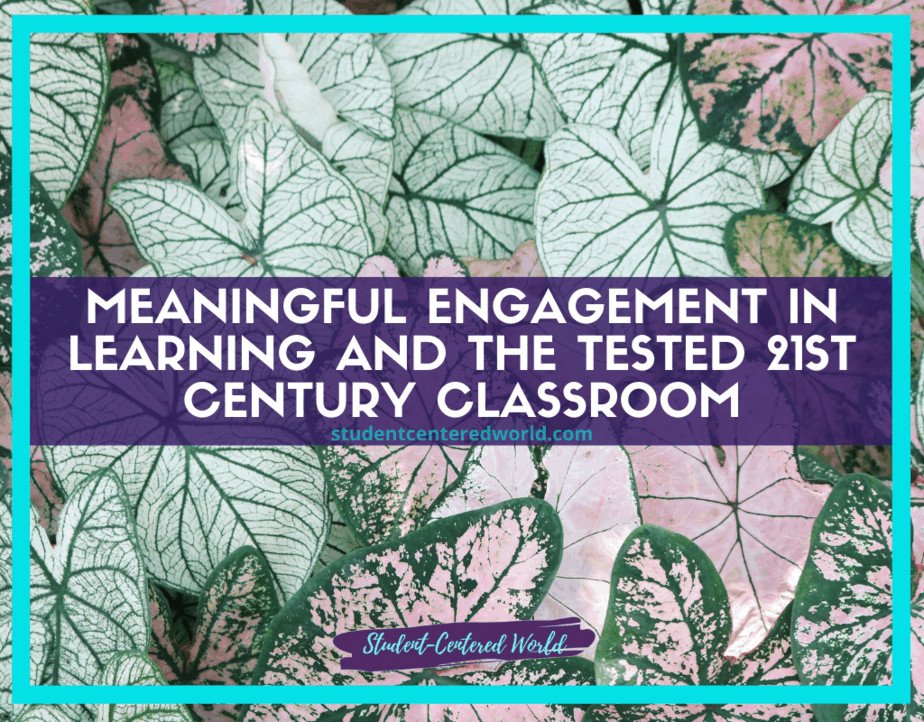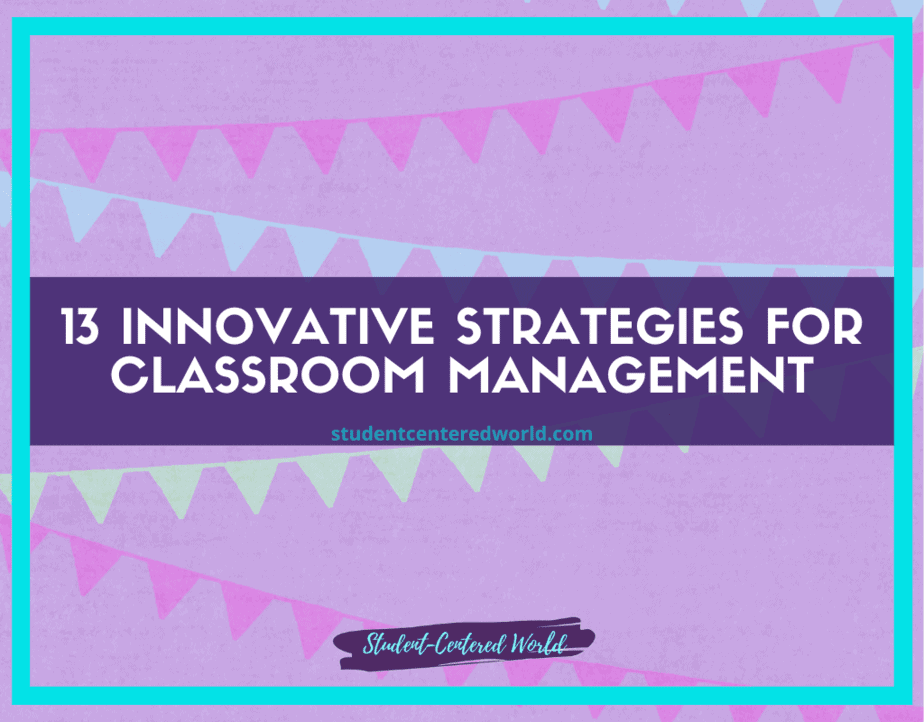3 Tips for an Amazing Student Engagement Strategy
If developing a student engagement strategy seems more daunting than helpful, then you’re in the right place. As teachers, we aren’t necessarily taught how to create a student engagement formula that works for us; rather, we are taught that if x, y, or z is “good enough”, engagement will happen on its own. While that may work haphazardly, if you learn how to create a consistent student engagement strategy, it will work no matter what you put in front of your students.
The great thing is that you can implement student engagement in your classroom immediately! Before I talk about student engagement strategies, let’s take a look at what student engagement really means.
I define student engagement as when students are focused on the lesson and are able to participate in student-centered activities.
The reason it is important to define student engagement at the beginning of this post is because student engagement does NOT mean student satisfaction, student respect, student effort, or student happiness. All these things are important… but they do not equal student engagement (though they may lead to it).
How to Create a Student Engagement Strategy
Developing a student engagement strategy does not happen without observation and analysis, particularly if you are new to this concept. If student engagement doesn’t happen naturally in your classroom, then it will take time and effort on your part to implement student engagement strategies into your lesson plans. Here are some suggestions from my experience:
- Take note of student engagement levels frequently. Some days will be better than others, and there may be different patterns throughout the school year (or even the day). For example, student engagement may be higher at 1 pm on a Tuesday because students are more alert. Take notes on what seems to work for student engagement levels in your classroom.
- Student engagement strategies don’t have to cost money or take a lot of time to implement. For example, towards the beginning of the school year, as you’re fine-tuning your student engagement formula, you can send students around the room to ask each student their name and how they spell it because that seems to get student engagement high. It also helps everyone learn names quickly.
- Student engagement strategies can be as simple as changing the way you ask a question. For example, if you are speaking and students aren’t engaged, then try to ask a “more engaging” question instead of your original one. It’s interesting to note that student engagement will reflect your student-centered approach rather than the content. (Are student-centered learners more engaged? Maybe.)
- Student engagement strategies don’t have to work for every student. For example, I’ve noticed that student engagement is usually higher when students are comfortable with each other (they know each other’s names and can expect student support). It’s also interesting to note that student engagement seems to be higher in classes where there is more student-teacher contact. So if student engagement is lower in a classroom, then student body language may be negative.

You will need to create a student engagement strategy that is aligned with your teaching mission and state and district student engagement policies. You also will need to determine the level of student engagement you want to achieve in your class and how to implement student engagement strategies that fit into your plan.
If the development of a student engagement strategy is new for you, then your first task should be asking someone with experience how they have managed student engagement. If student engagement is not an issue for you, then a student engagement strategy will likely include:
- student-centered instruction where students are working at their own pace on tasks and projects;
- student collaboration where students work together on a project or task with learning goals in mind;
- student self-reflection, which allows students to ask themselves questions about the things they do.
- student feedback on student work and student learning, which assesses student performance and provides a student perspective to teachers as they plan for future lessons.
Student engagement strategies that rely heavily on student participation will require you to have more student project time built into your day so that students have enough time to plan and complete projects. Build-in lots of time for student collaboration and student projects.
An effective student engagement strategy will require you to be flexible and responsive in the classroom so that student needs are addressed as promptly as possible.
While student self-reflection is a student engagement strategy no one has time for, it can be successful when students are given some time throughout the day to ask themselves questions about their learning or work performance.
Student feedback on student work and student learning should be done throughout the year so that students can begin to see their improvement over time.
You also will need to tap into student engagement strategy that is specific to student needs in your classroom, like:
- student use of restorative practices;
- the use of peer mentors, who give guidance and support to fellow students;
- student use of student leadership positions for student engagement.
- student involvement in instructional planning;
- students writing journal entries every night or weekly about what they are learning, what they want to learn, and how the class is going. (You can have students peer review these journals with constructive comments that will help student writers make future journal entries better.)
- student reflection time on student work and student learning where students think about what they are doing well, what they need to improve, or how the class is going.

Focus on the fundamentals first
If student engagement does not happen naturally in your classroom, then take some time to think about what you’re currently doing and how it can be changed so that it will happen naturally once you implement your student engagement strategy.
You don’t have to implement your student engagement strategy everywhere in your classroom right away. It’s better to start with one concept at a time and then move on from there. The more strategies you understand, the easier it will be for engagement to happen naturally in your classroom.
Teaching student engagement strategies will be easy if you have already had student-centered, student-driven lessons. You know the content, and so student engagement can happen naturally because you’ve reached a “comfort level” with student input — not because student engagement is forced.
In my experience, student engagement has always happened naturally after giving students the freedom to explore content in student-centered, student-driven lessons. In other words, student engagement doesn’t happen without student input (and student exploration).
It’s interesting to note that student engagement can be high even if the student is struggling with content. That being said, expecting student engagement without student support and/or student input will not work. Instead, begin to implement your strategies once student support and input become sufficient. (It’s interesting to note that student body language can vary greatly from student to student, so it will help if student engagement is defined in such a way that it includes student support and student input in the definition.) You can begin crafting your student engagement formula immediately (even before you meet your students), but putting everything into place needs to be a process that is methodical and that makes sense for your students.
If you have a specific student engagement strategy, like how to use flexible seating, yes, you can put that into play right away. Only students who wish to partake in the seating options will participate, anyway. However, longer-term, student-centric pieces of your student engagement formula, such as those pieces that deal with student intent, will need to be put into place with the proper timing (again, even if you know that you will be implementing it into the classroom).

Student engagement strategies can be interwoven into student-centered, student-driven lessons
Teach in a student-centered way (e.g., teach the content and ask students about student interests) so that student input is allowed (and student exploration has happened). Flexible seating and/or movement breaks are good examples of student engagement strategies that are student-centered.
Teach with student intent in mind. What makes your students “tick” as people? Incorporate that into the classroom as much as possible. What will make your students “engage” with the content at hand? This includes student support, student exploration of content (student interest), student control of their learning (e.g., student choice over what to learn about next), student engagement with content, student decisions within the classroom (e.g., student-initiated projects), student input into how the class will be run, etc.
Focus on student learning (e.g., student learning goals) that are student-centered and student-driven and i
Focus on student learning (e.g., student learning goals) that are student-centered and student-driven and investigate what happens when student support and student input are not there. If you’re looking for reasons why student engagement in your classroom isn’t happening naturally, then perhaps it’s because student support and student input are not there.
Find student-centered learning objectives that are student-driven and student-engaged, make them student-friendly, and teach those.
Bring the students into the discussion, but make sure you are well prepared (or better yet…students are well prepared) for student input so that it makes sense to them, too. When student input happens in a meaningful way, student learning is student-centered and student-driven.
Create student-engaged questions for students to explore the content with (lead them to student discovery).
Find a student’s interests and incorporate them into their learning through student choice.
Investigate what happens when student engagement isn’t there – do students work without being engaged, do student’s minds wander, student’s behavior issues occur?
Show students how they can engage themselves in the content through student choice.
Focus on student interests and incorporate those into student learning through student choice.
Bring students into the discussion (as much as possible).
Show students how they can engage themselves in the content through student choice.
Finally, look for other student engagement strategies that fit into the mix in your classroom. Only you will know what is best for your students (and you!).
Stop Driving the Teacher Struggle Bus
Are you struggling with student engagement, apathy, or keeping your class on track?
💫💫 There’s hope! 💫💫
Join my free teacher workshop “Choosing Choice” and in just 60 minutes, you’ll craft a practical plan to revitalize your teaching. Discover the magic of student choice in boosting engagement, gain quick implementation ideas, and explore strategies for year-long success.
Unlike overwhelming workshops, my approach guides you in real-time, providing more classroom options, reducing stress, and giving you more personal time.
Plus, you’ll earn a 1-hour professional development certificate and have 7 days of access.
Don’t miss this chance to transform your teaching; click below to secure your spot now!






